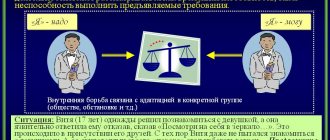Certain circumstances, misunderstandings, and a negative attitude towards the interlocutor lead to conflict.
This incident happens to everyone and it is a natural process that occurs in different life situations.
Experts highlight both the pros and cons of the conflict. There are many consequences to such incidents that you should be aware of.
You will find recommendations for correcting the hyperthymic type of character accentuation on our website.
Nature and reasons for its occurrence
Conflict arises when one side believes that the other is infringing on its interests.
When people have too different perceptions of what is happening , their opinions on a particular issue do not coincide, a clash occurs.
Each side tries to prove that it is right and rejects the opponent’s arguments. People stop hearing each other and become fixated only on their own point of view.
Respect for each other and tolerance disappear, hatred and contempt grow. is born to prove to the other side that you are right and to accept it.
Experts consider conflicts to be a natural phenomenon that arises during human socialization.
He tries to make friends, certain acquaintances appear. During communication, sometimes interlocutors realize that their opinions differ , and this gives rise to negative situations.
Conflicts are usually accompanied by disputes and aggression , but there are times when interlocutors come to a compromise and respect not only their own opinion, but also the opinion of their opponent.
Psychologists have identified several causes of conflict:
- Objective . Mismatch of interests, outlook on life. In this case, the parties cannot accept each other’s views and criticize.
- Organizational and managerial . Associated with a person’s professional activity, when an employee makes mistakes, feels pressure from a manager, or the boss does not carry out instructions, or is criticized by subordinates. Both sides are dissatisfied with each other, expectations do not correspond to reality.
- Socio-psychological . Usually this is an incorrect assessment of the results of activities, or the person treats an adult as a child and talks to him as if he were a little one, and does not give serious instructions.
- Personal . Mismatch of temperaments, characters, insufficient social adaptability, incorrect assessment of one’s own capabilities. Your own self-improvement will help prevent negative situations.
Such an incident can also be provoked by raising the voice, rude language, arrogance, lack of desire to talk, or solve the problem during communication.
Causes of conflicts:
Positive and negative consequences of conflicts
Conflict resolution can be complete or partial. Complete resolution means the end of the conflict, a radical restructuring of the entire image of the conflict situation. At the same time, the “image of the enemy” is transformed into the “image of the partner”, the attitude towards struggle is replaced by an orientation towards cooperation.
With a partial resolution of the conflict, only its external form often changes, but the internal incentives to continue the confrontation remain.
Successful conflict resolution is associated with certain conditions, namely:
timely and accurate diagnosis of its causes. In the course of this, objectively existing contradictions, interests, and goals are identified. Based on this analysis, the so-called business conflict zone is determined:
mutual interest of the parties in overcoming contradictions. This is possible with mutual recognition of the interests of each party, for which the subjects of conflicts need to free themselves from mistrust of each other;
jointly searching for ways to overcome the conflict. In this situation, a variety of means and methods can be used.
In sociological science, corresponding attention is paid to the development of technology for regulating and managing conflicts.
The task of conflict management is to prevent its escalation and reduce negative consequences. The subject of conflict management can be either one of its parties or, say, a third force that is not participating in it, but is interested in its resolution. No matter who is the subject of social conflict management, it is important to find ways to regulate conflict relations. The following measures can contribute to this:
make social conflicts (primarily shadow, implicit, latent) public, as open as possible. This will allow them to be brought under control and to respond in a timely manner to the processes occurring during the confrontation between the parties; reduce the degree of socio-psychological arousal.
Resolving social conflict is a rather complex matter. It can take different paths and use different methods.
The method of avoiding conflict can be expressed in the departure of a particular political figure from the political arena or the threat of leaving, in avoiding meetings with the enemy, etc. However, avoiding a conflict does not mean its elimination, because the cause itself remains.
The negotiation method avoids the use of violence. During the negotiations, the parties exchange opinions, which inevitably reduces the severity of the conflict, helps to understand the arguments of the parties, and objectively assess the true balance of power and the conditions for reconciliation. Negotiations allow you to consider alternative situations, achieve mutual understanding, reach agreement, consensus, and open the way to cooperation.
The method of using mediation is a conciliation procedure. Both organizations and individuals can act as intermediaries, and the functions of intermediaries can be performed not only by government agencies, but also by any other institutions and organizations. Practice confirms that a well-chosen mediator can quickly resolve a conflict where without his participation agreement would be impossible. Thus, in complex social conflicts in the West, the role of mediators is played by Nobel Prize laureates. This practice clearly demonstrates the high demands placed on the mediator’s personality (authority, morality, professional competence, high intelligence).
The method of postponing, which often means giving up one’s position. This action is common in practice. But here it is important to emphasize that the side that has “surrendered its positions”, as forces accumulate and the situation changes in its favor, will, as a rule, make an attempt to regain what was lost.
Method of arbitration, or arbitration. During the analysis, they are strictly guided by the norms of laws, including international law.
Finding ways out of conflict situations contributes to the development of other methods for resolving social conflicts.
Understanding the nature and content of public conflicts allowed us to develop the following recommendations that can help speed up the process of conflict resolution:
during negotiations, priority should be given to discussing issues related to the content of the conflict;
the parties should strive to relieve psychological and social tension;
it is necessary to demonstrate mutual respect for each other;
negotiators must publicly and demonstrably reveal each other’s positions and consciously create an atmosphere of public exchange of opinions;
all negotiators must show a tendency to reach consensus.
E.G. Logunova, Ph.D. Philosopher Sciences, Associate Professor
Necessary and sufficient conditions and factors
Conflict conditions are circumstances that provoke the emergence of negative situations. They can be objective and subjective. Objective conditions include:
- changes in the economic, political and social life of society,
- financial stratification of citizens, when people’s incomes differ significantly,
- violation of traditional, moral principles,
- illnesses: both physical and psychological.
The subjective conditions for the birth of conflict are:
- the person is too anxious and excited,
- stressful state,
- selfish behavior
- low moral and personal qualities of a person,
- inability to build relationships with other people.
factors causing conflicts . The main ones are the divergence of spiritual values, lifestyle, and life aspirations.
Often they also become negative character traits: pride, selfishness, arrogance, the desire to suppress, hot temper and emotionality.
Conversely, positive traits such as friendliness, tolerance of others, a positive attitude towards others, the ability to remain calm, and the desire to find a solution to a problem help to find a compromise .
Structure, constructive and destructive functions
The conflict consists of the following elements:
- An object . They can be material, spiritual or social values. They vary depending on the situation.
- Participants . These are individuals, groups of people, organizations and even states. Not only individuals, but also huge groups can conflict.
- Conditions, social environment. The role is played by what social class the participants belong to, where they live, and what professional positions they hold.
- Subjective perception .
Each participant in the conflict will perceive the situation in his own way and respond to it with certain emotions and feelings. They can literally overwhelm one person, while another will perceive what is happening calmly, without emotion.
According to psychologists, conflicts perform constructive and destructive functions. Design features include :
- Identifying contradictions. Conflict can highlight unresolved issues that exist between people.
- Assessment of individual psychological characteristics of a person . The parties to the conflict discover previously unknown character traits of each other.
- Easing mental tension. You can get rid of irritability and relieve tension.
- Personal development. A person gains experience communicating with people, learns to build communications with other people, and find a common language.
- Improving the qualities of individual activity. People's activity accelerates, and skills for behavior in extreme situations are developed.
In other words, the constructive functions are positive. They perform positive functions that best influence a person’s personality, and conflict acts as a kind of development and gain of experience.
Destructive functions are different, they are negative and include:
- Violation of the communication system, a person faces difficulties in communicating with people.
- A person experiences negative emotions.
- Growing hostility towards the other side of the conflict.
- One conflict may be followed by another if the parties have not resolved the differences that have arisen.
Conflict has both positive and negative functions.
Both sides experience certain emotions and feelings during the conflict, so psychologists say that these incidents are experiences .
In one case it can be positive, and in another negative.
Conflicts: constructive or destructive, how to determine? Watch the video:
Positive functions of conflicts
Modern understanding of conflicts in social sciences is based on the idea of the positive functions of conflict.
This is easily accepted when it comes to the theoretical arguments of sociologists about the processes occurring in social systems. But the psychologist deals with living people and sees in front of him a suffering person who is having a hard time experiencing life’s difficulties, which can be emotionally difficult to combine with reasoning about the benefits of conflicts.
However, modern psychology is also characterized by the recognition of the dual nature of conflict, including its positive role.
Conflict is the source of development. The most important positive function of conflict is that, being a form of contradiction, conflict is a source of development. The more significant the conflict is for the participants in the situation, the potentially stronger its impact on their intellectual development. The thesis about contradictions as a source of group development, including possible competitive processes, can also be considered generally accepted. Thus, B.F. Lomov believes that in joint activities “rivalry (cooperation) plays the role of a kind of “catalyst” for the development of abilities.” Competition plays a similar function in stimulating activity and development in a group.
Conflict is a signal for change. Of the other positive functions of conflict, the most obvious is the signaling function. Discussing the types of critical situations, F. E. Vasilyuk emphasizes the positive role, the “need” of internal conflicts for life: “They signal objective contradictions in life relationships and provide a chance to resolve them before a real collision of these relationships, fraught with disastrous consequences.”
Conflicts perform a similar signaling function in interpersonal relationships. Let’s take the relationship between parents and child as an example. If parents perceive the child’s disagreement, his new claims and attempts to discuss them with parents solely as disobedience, then they will fight his disobedience, insist on their own, and thereby most likely worsen, and perhaps even destroy, their relationship with the child. The gradually accumulating tension is like steam, the pressure of which bursts a tightly closed boiler.
A constructive response would be to perceive what is happening not as disobedience, but as a signal of the need for change. Perhaps an analogy with pain would be appropriate here. The pain is unpleasant, but any doctor will tell you that it serves an important and useful function. Pain is a signal that something is wrong in the body. By ignoring or drowning out the pain with sedative pills, we remain with the disease. Conflict, like pain, serves as a signal, telling us that something is wrong in our relationships or in ourselves. And if we, in response to this signal, try to make changes in our interaction, we come to a new state of adaptation in the relationship. If we reach a new level of adaptation at each stage of our relationships, this ensures the preservation, “survival” of our relationships.
Conflict is an opportunity for rapprochement. Examples can be found on psychological material that illustrate other positive functions of conflict, for example, “communicative-informational” and “connective” (in Coser’s terminology).
As an example, here is the story of one young woman. She got married very early, she was not yet nineteen years old. Her chosen one was several years older than her, and although he was also young, it seemed to her that he was wiser and more experienced. Perhaps this is what led to the fact that, despite her good relationship with him, she felt some kind of constraint in her soul, felt the distance separating them. After the birth of the child, their relationship began to deteriorate and finally approached that dangerous point, after which, perhaps, separation awaited them. However, there was that often unexpected breakthrough for which there is always hope. They began to sort out their relationship and during this frank conversation they understood each other. Having told this rather banal story, the woman added at the end: “I am so glad that this conflict was between us then. Because since then my husband and I have become absolutely close people to each other. I can tell him anything and everything that’s on my soul.”
She associates this new level of relations between them with the conflict that occurred. The moment of breakthrough, when people have nothing to lose when they try to break through to each other, can be their last opportunity for mutual understanding. No wonder sociologists of the Chicago school said: “Conflict is an opportunity to talk openly.”
Positive functions of intragroup conflicts. The traditional point of view not only of sociologists, but also of psychologists who worked with groups was that conflicts are a negative phenomenon for the group and the task is to eliminate them. The tendency to seek social harmony in groups dates back to the “human relations” school: avoiding conflict, seen as a “social disease”, and promoting “equilibrium” or a “state of cooperation”. However, thanks to the conflict, it becomes possible to initially establish unity or restore it if it was previously broken. Of course, not every type of conflict will contribute to the strengthening of the group, just as not in all groups conflict can realize similar functions. The presence of these positive conflict potentials is determined by its type, as well as by the characteristics of the group.
Every group contains the potential for conflict due to the periodic rivalry between the demands of individuals. The nature of the group will significantly influence the characteristics of these conflicts, in particular their functions. Thus, Coser believes that the closer the group, the more intense the conflict. If, nevertheless, a conflict arises in such a close-knit group, then it will proceed with particular intensity due to the “accumulated” discontent and complete personal involvement characteristic of a group with close ties. Conflict in groups of this type will threaten their very foundations and therefore be destructive.
The nature of the group’s relations with the external environment will also be significant for intragroup conflict. Thus, groups that are in a state of more or less constant confrontation with other groups will tend to more fully involve their members personally in common activities and to suppress deviations from group unity and disagreement. Greater tolerance to intragroup conflicts will be characteristic of groups whose relations with the external environment are more balanced.
Internal conflict also serves as a means of identifying conflicting interests among group members and thereby contributes to the possibility of a new agreement, ensuring the restoration of the necessary balance.
Conflicts often lead to the creation of associations and coalitions within groups, which ensures interaction between members of the entire association, reduces isolation, and creates the ground for individual activity of group members.
In general, pointing out the positive possibilities of conflict in flexible social structures, L. Coser calls it the most important stabilizing mechanism, a mechanism for adapting norms to new conditions.
Conflict is an opportunity to relieve tension and “heal” relationships. The function of relieving tension, “improving” relationships, which the conflict potentially contains, can be purposefully used in pedagogical practice. For example, A. S. Makarenko considered conflict as a pedagogical means of influencing people’s relationships.
It is interesting that R. May considers it possible to use the same technique of intensifying experiences to initiate a beneficial crisis in psychotherapeutic practice. He writes about how he once received an extremely emotional letter from a young man who asked him for help: “In my response letter, I aimed to extremely aggravate his feelings and cause a crisis. I wrote that he had become accustomed to his position as a spoiled child, who was always carried around, and now in his suffering there is nothing but self-pity and a complete lack of courage to cope with the current situation. I deliberately did not leave any loophole to save the prestige of his “I.” May believes, judging by the response, that his goal has been achieved and has led to constructive steps.
Emphasizing the potential positive possibilities of conflict should not make us forget about its likely destructive role in the life of an individual. The idea can be considered generally accepted not only of the positive significance of an individual’s effective resolution and overcoming of emerging intrapersonal crises, conflicts, and contradictions, but also of the negative and even destructive impact that their failure to overcome can have on the development of a healthy personality. We can evaluate a person's recovery from a conflict or crisis as productive if, as a result, he is truly “freed” from the problem that gave rise to it in such a way that the experience makes him more mature, psychologically adequate and integrated.
The emotional experience of a crisis situation, no matter how strong it may be, does not in itself lead to overcoming it. In the same way, analyzing a situation and thinking about it only leads to a better understanding of it. The real problem is the creation of new meaning, “meaning generation”, “meaning construction”, when the result of the individual’s internal work to overcome and live through critical life situations are changes in his inner subjective world - the acquisition of new meaning, a new value attitude, restoration of mental balance and etc.
On the contrary, those strategies that, in essence, are psychologically ineffective, no matter how the individual himself evaluates them, actually turn out to be aimed at weakening, mitigating the severity of the crisis being experienced and the emotional states accompanying it. If we recall the previously used medical analogy, we can say that in the first case, a person, having felt pain, tries to find out its cause and cope with it by curing the disease, and in the second case, he simply takes pills, trying to drown out the unpleasant sensations.
The general practical position can be expressed in the already quoted words of R. May: “...Our task is to transform destructive conflicts into constructive ones.”
Goals and motives
The goal of the conflict is to change the situation in a favorable direction . A person strives to improve the situation and solve the issues that trouble him. He wants to get rid of misunderstandings, find answers, decides to find out whether to continue the relationship or end it.
Motives are formed by internal components, beliefs, and outlook on life. They are also influenced by circumstances and the social environment.
Motives are the force that pushes individuals toward conflict . They can vary greatly depending on the situation. As a rule, they are:
- interests,
- values,
- goals,
- ideals,
- beliefs.
The social conditions in which a person finds himself can have a certain impact on the individual’s mood, his mood and worldview.
Strategies for dealing with conflict:
POSITIVE CONSEQUENCES OF CONFLICTHow to determine a person's character by appearance? Find out about this from our article.
Thanks to many studies in the field of conflict, it has been possible to identify a large number of positive consequences or functions of the ongoing conflict. Positive consequences are identified both at the personal level, where the participants in the conflict are considered, and at the social level, where the environment of the conflict is considered.
Positive consequences for the first category (at the personal level)
:
1) the conflict is aimed at creating structure in a social group, it contributes to the unity of like-minded people or the group as a whole;
2) conflict stimulates the development of personality and individuality, provides new knowledge useful in the future for preventing a conflict situation;
3) conflict eliminates the “submission” syndrome, provoking individuals to activity;
4) the conflict performs an informational function (in a conflict situation, participants reveal many personal traits and characteristics, therefore they get to know each other better);
5) conflict can improve interpersonal relationships, has a positive effect on the quality of activities and behavior of the parties involved;
6) a clash of views and opinions leads to an expansion of behavioral strategies and the boundaries of the worldview of the participants in the conflict.
Positive consequences and functions of conflict at the social level
:
– conflict forces already existing relationships, groups, systems to change towards improvement;
– the innovative function of the conflict is also aimed at developing existing interactions;
– conflict, as an indicator, reveals advantages and disadvantages in the system, finds the weakest connections and reveals the strengths of relationships – diagnostic function;
– conflict resolution relieves the mental and emotional tension of the participants and the entire environment as a whole, acting as a kind of release for the psyche and body of all subjects of the conflict;
– conflict explores opinions common in the environment, reveals collective moods and attitudes, contributes to the actualization of democratic and humanistic values – the moral function of conflict;
– conflict creates more harmonious relationships among the participants and optimizes the external conditions in which the participants find themselves;
– the function of cohesion of the conflict, the establishment of a more friendly environment;
– conflict is used as a means of stimulating more productive activities of participants;
– modeling a conflict situation in business or role-playing games performs a cognitive function;
– conflict can be considered as the prevention of conflict situations in the future, the value of consent and conflict-free behavior increases
Table of contents
Positive and negative sides
These incidents can have both positive and negative sides.
Positive consequences
The positive consequences of these incidents are:
- Development of interactions both between individuals and between social groups.
- Such situations improve relationships. They move to a new level, people open up to each other.
- Conflicts reveal the advantages and disadvantages of certain relationships.
- With the help of such situations, more harmonious relationships can be built; individuals do not hide their real feelings.
- The participants in the situation get to know each other.
Thanks to such situations, people figure out whether they should continue to be friends or not, build relationships or not .
Relationships become more trusting and misunderstandings are eliminated.
Conflicts have a positive impact on society only if they occur rarely , do not torment people internally, and do not lead to stressful conditions.
Then people trust each other more, are more open and undisguised.
If they happen frequently, society becomes embittered, aggressive, cases of crime increase, and people cannot establish communication and are unable to build relationships.










